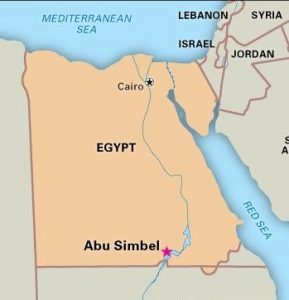
Where is Abu Simbel located?
Abu Simbel is a site located 300 km south of Aswan and 20 km on the north of the border with Sudan on the western banks of Lake Nasser. It was located on one of the most populated and agriculturally productive regions of Ancient Egypt, for 3000 years, that is on the western banks of River Nile between its first and second cataracts before its relocation in the 1960s. Owing to its archaeological significance, this site is protected by the UNESCO since 1960 when it was relocated as a part of its International Campaign to save the Monuments of Nubia (1960-80).
WHAT IS ABU SIMBEL FAMOUS FOR?
The site of Abu Simbel is famous for two rock-cut temples built during the reign of Rameses II. The big temple is dedicated to deified Ramses in the form of Osiris, Sun God Ammon Re of Thebes and Re-Harmachis of Heliopolis and the adjacent smaller temple is dedicated to his wife Nefertari and Goddess Hathor was also worshipped in the same.
WHO BUILT ABU SIMBEL AND WHY?
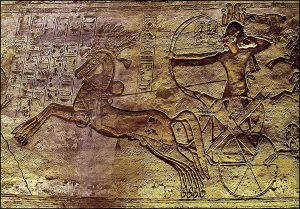
Ramses II and the battle of Kadesh
Abu Simbel temples were built by Egyptian Pharaoh King Ramses II (ruled from c.1279-13 BCE) to commemorate his victory in the Battle of Kadesh. When the Hittites of modern-day Turkey attacked the trading town of Kadesh, a 14 year old Rameses II decided to prove his mettle and establish his authority by defeating them. Rameses II set out in the battle with a force of 20,000 men, divided equally into four troops named after the Egyptian deities- Ammon, Re, Ptah and Seth. After a month, he with his troops reached the town of Kadesh on the banks of Orontes river and captured two of the Hittite spies who duped Ramses II into believing that the Hittite king Muwatalis had fled. In reality the Hittites were hiding nearby, planning to attack Ramses army completely off-guard. Ramses had crossed the Orontes river with only two of his troops- Ammon and Re while the other two troops stayed behind. Ramses had planned an overnight rest before attacking the town of Kadesh but the Hittites attacked him in the dark of the night. His army men were either killed or fled away, leaving the Pharaoh alone with his flag bearer Mena. In these desperate times, Rameses II prayed to God Ammon-Re of Thebes who apparently blessed him and strengthened him which finally led to his victory in the battle.
Coating his political achievements with the mystique of religion and subsequently deifying himself, Rameses II built the Abu Simbel Temples to memorialize his legacy. It was intended to immortalize him and remind the visitors and the people of the great deeds of the Pharaoh.
DISCOVERY

In 1813, Swiss archaeologist John Lewis Burckhardt was the first person to visit Abu Simbel after he had heard of the story of a giant head lying on the sand from a local boy, allegedly named Abu Simbel (apparently from where the temple derives its name). But at that time the bigger temple was buried in the sand so he could not enter the temple and could only see the stone head of the Pharaoh, albeit he was successful in excavating the smaller temple dedicated to Nefertari. In 1817, Giovanni Belzoni, a former circus performer and a hydraulic engineer in the court of Pasha Mohammed Ali, managed to enter the temple in his third attempt after having heard about it from Burckhardt. Auguste Mariette cleared the structure from sand in 1869. In 1892, Captain Johnson, R. E., restored the facade and built two walls to protect the structure from the encroaching sands. Belzoni had taken away most of the treasures that he had found in the temple and sold it to the Europeans. Only a few of the treasures have been recovered.
TEMPLE STRUCTURE, ORNAMENTATION AND ITS STATUES
THE BIG TEMPLE
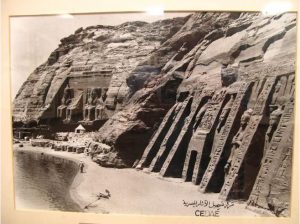
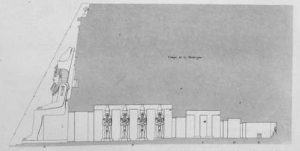


The temple is originally cut from single rock cliff in the second cataract of river Nile. It is 30 m in height and 35 m in length. The temple entrance has four colossal seated structures of Ramses II, two on either side, each being more than 20 m high, wearing the double crown of Upper and Lower Egypt. The statues of Queen Nefertari, the Queen mother Muttuya and some of the royal children embraces the Pharaoh’s legs. The fore-court can be reached from the river through a flight of steps, at the end of which one finds a facade with engravings of Ramases’ captives- Hittites, Nubians and Libyans and hollow cornice and embellished balustrade.
The Great Hypostyle hall (58 ft by 54 ft) of this temple has two rows of four pillars topped by Hathor heads and engraved with Rameses’ statues and decorated with the figures of king and queen giving offerings to various deities. A smaller four-pillared Hypostyle hall (36 by 24 ft) is connected with a transverse chamber by three doors. Other that these, there are eight ancillary chambers too attached to either of the halls and they acted as store rooms for temple utensils and furniture. The walls and pillars are decorated with the scenes and important events from the life of Ramses II. The scenes depict his achievements as the destroyer of his enemies like Asians and Nubians and him offering them to the various Egyptian deities. The battle of Kadesh which took place in 1285 B.C., and its associated events, like a wounded soldier being treated, horses being fed, have been depicted on the North wall.
The depictions on the walls of second hypostyle hall are purely religious and decorative in nature. The central door of the western wall leads to a sanctuary where the carved figures of Ptah, Amen, deified Ramses and Re Horakhty are present. This sanctuary bathes in the sunlight twice a year owing to the orientation of the entrance to the east. Every year on the 21st of February and on the 21st of October, the sun rays enlightened the figures of all the deities except Ptah since he was the God of the underworld. This is an extraordinary example of yet another scientific achievement of the Egyptians, this time in the field of Astronomy.
An interesting thing to be noted is that nowhere in the first hall can one see Ramses as deity and it is only in the wall dividing the first hall from the second hall that one starts seeing the deification of the Pharaoh. This could refer to a gradual unfolding of the events of the life of the Pharaoh, as proved by the engraving and reliefs on the walls which also show his achievements as the crown prince.
THE SMALL TEMPLE

The architecture of this temple mirrors the Temple Proper to its south but on a smaller scale. This temple is 12 m in height and 28 m in length. The entrance to the temple is adorned yet again with two colossal statues of Rameses II and one of Nefertari, of equal height on each side, with the total of statues being six. The equal size of Nefertari’s statue is proof of the respect and somewhat equal status that this favourite wife of the Pharaoh enjoyed in his court and life. The roof of the hypostyle hall is decorated with the scenes featuring Ramses II defeating his enemies before Amen and Horus, with Nefertari looking on. This was only the second time that a Pharaoh had dedicated a temple to his wife, the first being Akhenaten who had dedicated a temple to his wife Nefertiti.
WHY WAS ABU SIMBEL RELOCATED?
BEFORE RELOCATION
In 1960, the Egyptian government under President Nasser decided to build the Aswan Dam on the Nile river to provide hydroelectricity for Egypt and to improve irrigation on this land to provide for agriculture in this area, earlier too arid for it. But the construction of the Dam would lead to the flooding of the the flooding of the temple of Abu Simbel. It was clearly a deadlock between saving the past versus developing the present, further complicated by the contemporaneous political situation where President Nasser was unwilling to side with the USA, UK and the World Bank in the Cold War even if they paid huge sums for the Aswan Dam project which finally led to their withdrawing of the offer and the Egyptian government siding with the Soviet Union for the project. Now a parallel project began upstream and downstream with Nasser and the Soviets planning for the Dam while the Western countries and the UNESCO planning to save the historical monuments upstream.
Initially the French proposed for the construction of a second Dam around Abu Simbel to resist the rising water owing to the Aswan Dam but this plan was rejected owing to the huge expense of 82 million dollars required in it, the requirement of a large pumping station and an indefinite maintenance. Next the Italians proposed a plan in which they proposed that the temple would be cut off the rock and encased in concrete while the entire site was raised on cm at a time with the help of 650 synchronized hydraulic jacks. But this too was rejected since the jacks were believed not to be strong enough to support the temple structure along with the concrete encasement.
The Brits also proposed a unique plan according to which they would allow the flooding of the site and then allowing the tourists to view the site from underwater glass tunnels, but this too was rejected since the water of the River Nile was impure and would damage the temple unless a purification dam was built, again a very costly endeavour.
AFTER RELOCATION
Finally, a Swedish team from a geological engineering firm proposed a plan in 1963 according to which the temples would be cut into blocks of 20 to 30 tons each and then they would be moved individually while the temple would be recreated 208 m away and 65 m up from the original site. A much less costlier plan, this was supported by the USA but not by the UNESCO since it involved the cutting of old monuments and hence a possibility of potential damage. However this plan was finally approved in the absence of an alternative cost effective better plan.
But the entire task was not an easy one and immense care had to be ensured so as to prevent any damage to this historical grandeur. No cuts were made into the faces of the statues or other intricately designed areas of the temples. Cuts to be made determined the saws that would be used to achieve it and sand was used as fillers, shock absorber and a buffer between stone blocks. The reconstruction involved the creation of an artificial hill and the mortar used in the reconstruction was made out of local Nubian sand so as to resemble the original site. An artificial dome was built in the new site to support the structure. Some 16,000 blocks were moved using modern methods and this relocation is still the best example of rescue archaeology. Due to the relocation the illumination of the inner sanctum is late by one day.
Even the the smaller statuary and stelae surrounding the original complex were also moved to the new site. These stelae depicted Rameses defeating his enemies, his marriage to Naptera- a Hittite Princess as an outcome of the Battle of Kadesh, various gods and many more themes. It is from one of these stelae that we come to know how Ramases has assigned the construction of this temple to Asha-hebsed and he was the one who had organised the workforce that worked for the construction of this temple.
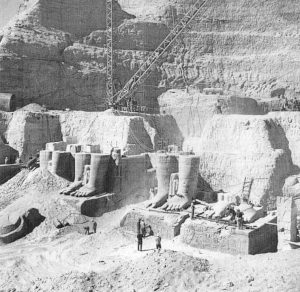
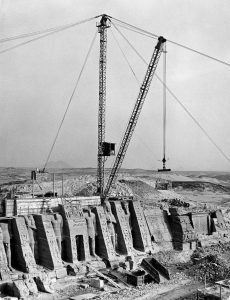
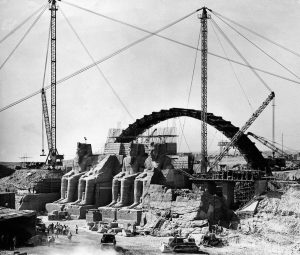

The entire reconstruction, which lasted from 1964 to 1968, was a part of a larger project to save other Nubian monuments undertaken by the UNESCO. The project lasted for 20 years and saved 22 sites, thanks to the 80 million dollars donated by 50 countries and several other organisations.
IS ABU SIMBEL WORTH VISITING AND CAN WE GO INSIDE IT?
After the Pyramids of Giza, it is the most visited ancient site and definitely its worth it, if not for anything else the craftmanship and the effort of hundreds or thousands of workers whose toil and hard work had produced this architectural marvel. A good guide is always welcome and also advisable if one is interested in understanding the hieroglyphs inside and make the most of their visit.